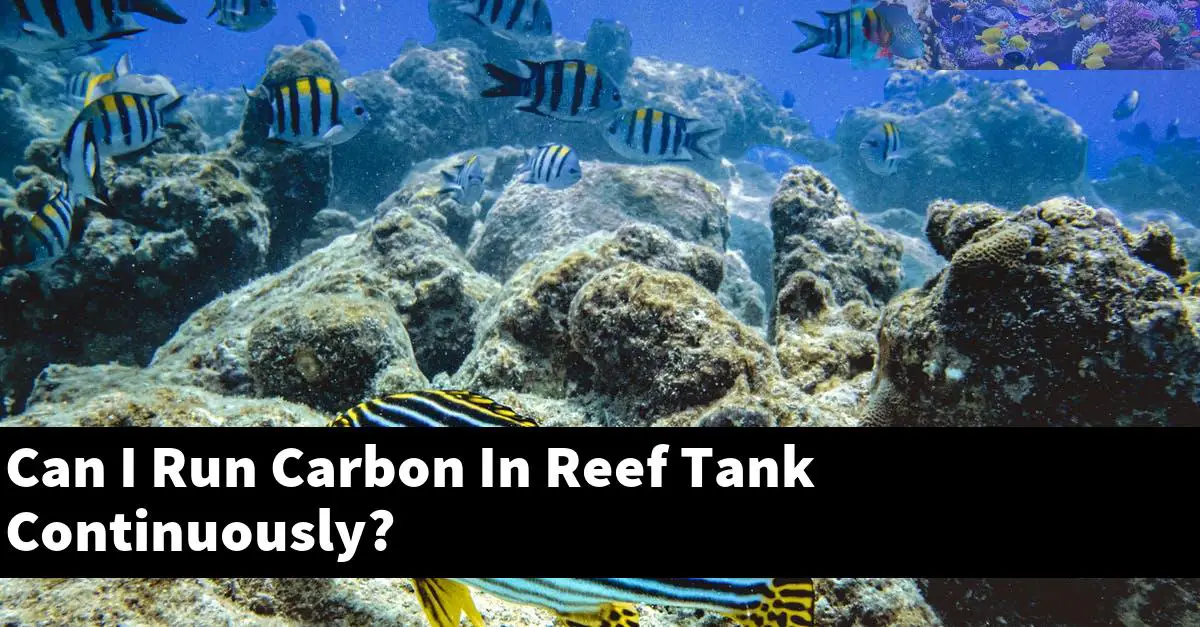Carbon can be used in reef tanks to help remove impurities from the water. It is important to make sure that the carbon is changed regularly, as it can become saturated and stop being effective. Some hobbyists choose to run carbon continuously in their reef tank, while others prefer to use it on a more intermittent basis.
Is it okay to run carbon in a reef tank continuously?
It depends on a number of factors, including the size and layout of the tank, the type of coral and fish that are being kept, and the overall maintenance schedule for the tank. Generally speaking, it is generally acceptable to run carbon in a reef tank on a continuous basis as long as the tank is properly maintained.
Will running carbon in a reef tank help remove impurities?
A reef tank running carbon can help remove impurities, but it is not a replacement for a regular water change. A carbon filter will not work as well if the tank is not regularly cleaned.
How often should I change the carbon in my reef tank?
There is no definite answer to this question as it largely depends on the type of reef tank and the size of the carbon dioxide supply. However, it is generally recommended that reef tanks be carbonated every two to four weeks.
API REEF MASTER TEST KIT Reef Aquarium Water Test Kit 1-Count
(as of July 21, 2024 05:07 GMT +03:00 - More infoProduct prices and availability are accurate as of the date/time indicated and are subject to change. Any price and availability information displayed on [relevant Amazon Site(s), as applicable] at the time of purchase will apply to the purchase of this product.)Instant Ocean Reef Crystals Reef Salt, Formulated Specifically For Reef Fish Tank Aquariums
$66.70 (as of July 21, 2024 05:08 GMT +03:00 - More infoProduct prices and availability are accurate as of the date/time indicated and are subject to change. Any price and availability information displayed on [relevant Amazon Site(s), as applicable] at the time of purchase will apply to the purchase of this product.)AquaIllumination Prime 16 HD LED Saltwater Reef Aquarium Light - Black
15% OffWhat are the benefits of running carbon in a reef tank?
Running carbon in a reef tank can provide many benefits to both the tank and the coral. Carbon dioxide is an important component of a reef tank’s environment, and running it through a co2 scrubber will help to keep the tank at a regulated ph level.
This can help to keep the coral healthy and prevent them from experiencing calcium carbonate deficiencies. Additionally, running carbon can help to remove harmful toxins from the water, and it can also help to oxygenate the water.
This can help to promote the growth of healthy coral colonies.
Are there any downsides to running carbon in a reef tank?
There are a few potential downsides to running carbon in a reef tank.
- The first is that carbon is a foreign object that could disturb the natural coral ecosystem.
- Secondly, if the carbon is not properly filtered it could produce organic waste that could harm the reef.
- Finally, carbon can add a distinctive “charcoal” smell to the tank, which some reef enthusiasts may not enjoy.
How long can I run carbon in my reef tank before needing to replace it?
Assuming a reef tank is maintained at a temperature of 76-78 degrees Fahrenheit, running a carbon filter can last anywhere from 6-12 months. It is important to keep in mind that the lifespan of a carbon filter will vary depending on a number of factors, including the size of the filter and the type of coral in the tank.
It is also important to note that the lifespan of a carbon filter will be shorter if the tank is maintained at a high or low ph level, as high ph levels can cause the carbon to break down more quickly.
What types of impurities does carbon help remove from reef tanks?
Carbon helps remove a variety of impurities from reef tanks, such as organic material, toxic metals, and other pollutants. It does this by promoting the growth of bacteria that can break down these substances.
This process is known as biotransformation.
Is carbon dust harmful to fish?
Carbon dust is not harmful to fish in an aquarium. Fish excrete waste that contains ammonia, and without the presence of carbon dioxide in the water, that ammonia would quickly build up to toxic levels.
So don’t worry about adding a little bit of carbon dust to your aquarium- it’s actually good for your fish.
How much flow does a carbon reactor have?
The proper flow rate for a carbon reactor will vary depending on the size and design of the reactor, but it is typically in the range of 1-10 liters per minute.
In order to maintain a stable flow of carbon dioxide into the reactor, the pump must provide a certain flow rate. If the pump is too small, the carbon dioxide will not enter the reactor quickly enough and the reaction will stop.
If the pump is too large, the carbon dioxide will enter the reactor too quickly and create an unstable environment. The correct flow rate ensures that the reactor has a steady supply of carbon dioxide to continue reacting.
Summary
Carbon is used to remove impurities from the water in reef tanks. It is important to make sure that the carbon is changed regularly, as it can become saturated and stop being effective.





















